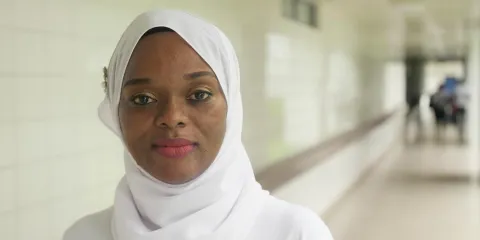Día Internacional de la Mujer 2024: Reimaginar la atención de las ENT para y por las mujeres

Muchas mujeres sufren discriminación en el acceso a la atención sanitaria, especialmente aquellas que viven en entornos de bajos recursos. Esto debe terminar. En el Día Internacional de la Mujer, activistas de las ENT reflexionan sobre los desafíos de género que han enfrentado en relación con las enfermedades crónicas, arrojando luz sobre la importancia de que los gobiernos apliquen una perspectiva de género a la cobertura sanitaria universal.
La falta de acceso a la salud es uno de los efectos más crueles de la inequidad. Varios factores contribuyen a esta realidad, incluido el género y otros determinantes sociales interrelacionados como la pobreza. Las barreras a la salud específicas de género impiden que muchas mujeres que viven con ENT tengan un diagnóstico oportuno o un tratamiento adecuado y asequible, particularmente en los países de ingresos bajos y medianos (PIBM) y en contextos humanitarios. Su testimonio y participación significativa son cruciales para garantizar una respuesta equitativa a la carga de las ENT.
Activistas con experiencias de vida compartieron sus historias sobre prácticas discriminatorias en el acceso a los servicios de ENT en la nueva serie del proyecto Diarios de las ENT cuyo tema es la equidad y la cobertura sanitaria universal. El testimonio de las mujeres participantes sirve para ilustrar los numerosos desafíos específicos de género que existen en relación con las enfermedades crónicas.
Las normas de género, junto con las costumbres sociales y culturales, pueden resultar muy limitantes para las mujeres que buscan atención médica. Algunas enfermedades exclusivas de las mujeres, como las de mama o el cáncer uterino conllevan un estigma, mientras que las familias tienden a priorizar la salud de sus niñas y niños y la de los hombres sobre la de las mujeres. Modina Khatun, una activistas con experiencia de vida en múltiples enfermedades crónicas y que vive en Bangladesh como refugiada, lo expresó de esta maner en su diario visual:
“Las mujeres aquí no se sienten cómodas hablando mucho ni compartiendo ningún síntoma corporal debido a las opiniones religiosas y las barreras idiomáticas. […] Cuando se trata de obtener ayuda para mejorar nuestras condiciones de salud, parece que algunas personas tienen el camino claro, mientras que otras tropezamos en la oscuridad”.
Las mujeres suelen ser las únicas cuidadoras en el hogar. Esto a menudo lleva a que abandonen la educación o el trabajo y dediquen todo su tiempo y energía a cuidados de otras personas, a expensas del cuidado de su propia salud física y mental.
“Siento que cada cuidadora atraviesa emociones poderosas como son la ansiedad, la ira, el miedo, la negación y la desesperación a lo largo de este camino con las ENT. Todas estas experiencias suelen provocar agotamiento físico y mental. Es una tarea desalentadora para las cuidadores mantener un equilibrio entre su propia salud y la salud de sus seres queridos”.
- Del diario escrito de Sabiha Khan, quien vivió la experiencia del cáncer como cuidadora, viviendo en la India.
La asequibilidad del tratamiento es otra barrera importante para el acceso de las mujeres a la atención sanitaria. No sólo tienden a tener menos poder de decisión financiera en el hogar, sino que también padecen enfermedades invisibles que no están cubiertas por los servicios de salud en muchos países de ingresos bajos y medianos, como por ejemplo, la endometriosis, una enfermedad del útero. Este es el caso de Catherine Berkoh, una activista con experiencia viviendo con endometriosis, en Ghana, y que fue diagnosticada erróneamente durante 11 años mientras enfrentaba gastos catastróficos para cubrir su tratamiento. En su diario visual, que apareció en la segunda serie del proyecto de los Diarios de las ENT sobre el tema de asequibilidad de la atención y cobertura sanitaria universal, dijo:
“Existe una gran ignorancia y muchos conceptos erróneos sobre las ENT, y la endometriosis apenas se reconoce porque el dolor menstrual se considera normal; por lo tanto, hay una falta de apoyo financiero del gobierno”.
Las mujeres embarazadas también corren un mayor riesgo de padecer enfermedades no transmisibles como la hipertensión, la diabetes y las enfermedades cardiovasculares. Las complicaciones del embarazo relacionadas con enfermedades crónicas a menudo no se tratan. La solución sencilla para evitar más muertes de madres es integrar la prevención, la detección y el tratamiento de las ENT en los programas de salud materna existentes. Conoce el testimonio de Sujata, una partera comunitaria en India.
La cobertura sanitaria universal (CSU) tiene el potencial de reducir las inequidades en salud que enfrentan las mujeres, pero los sistemas y las políticas de salud deben diseñarse e implementarse de manera que sean asequibles y accesibles para ellas y basados en su participación. En el Día Internacional de la Mujer de este año, los testimonios de activistas con experiencias de vida que han enfrentado desafíos específicos de género en relación con sus condiciones nos recuerdan la necesidad de adoptar una perspectiva de género en la equidad en salud.